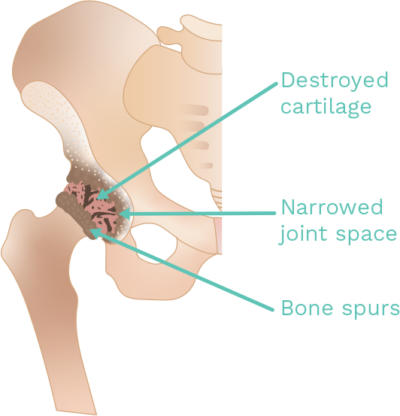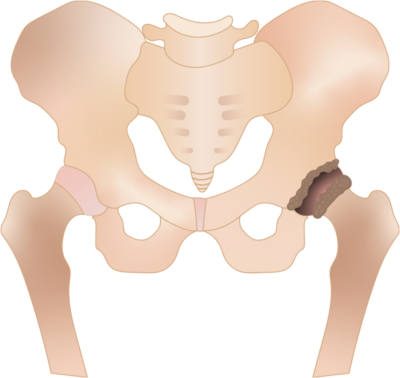Sometimes called “wear-and-tear” arthritis, osteoarthritis is a common condition that many people develop during middle age or older.1 Osteoarthritis is a degenerative type of arthritis that occurs most often in people 50 years of age and older, though it may occur in younger people, too.2 In 2011, more than 28 million people in the United States were estimated to have osteoarthritis. It can occur in any joint in the body, but most often develops in weight-bearing joints, such as the hip.3
Hip Osteoarthritis (Hip OA) causes pain and stiffness. It can make it hard to do everyday activities like bending over to tie a shoe, rising from a chair, or taking a short walk.4
Because osteoarthritis gradually worsens over time, prompt treatment can lessen the long term impact on a patient’s life. Although there is no cure for osteoarthritis, there are many treatment options to help patients manage pain and stay active.5

1 https://orthoinfo.aaos.org/en/diseases–conditions/osteoarthritis-of-the-hip
2 https://www.atlanticortho.com/degenerative-joint-disease-osteoarthritis
3 https://orthoinfo.aaos.org/en/diseases–conditions/osteoarthritis-of-the-hip
4 Ibid.
5 Ibid.
“In osteoarthritis, the cartilage in the hip joint gradually wears away over time. As the cartilage wears away, it becomes frayed and rough, and the protective joint space between the bones decreases. This can result in bone rubbing on bone. To make up for the lost cartilage, the damaged bones may start to grow outward and form bone spurs (osteophytes).”
Osteoarthritis develops slowly and the pain it causes worsens over time.
6 https://unovahealth.com/osteoarthritis-of-the-hip/
Cause

“Osteoarthritis has no single specific cause, but there are certain factors that may make you more likely to develop the disease, including:
• Increasing age
• Family history of osteoarthritis
• Previous injury to the hip joint
• Obesity
• Improper formation of the hip joint at birth, a condition known as developmental dysplasia of the hip
Even if you do not have any of the risk factors listed above, you can still develop osteoarthritis.”7
Symptoms
“Osteoarthritis symptoms often develop slowly and worsen over time. Signs and symptoms of osteoarthritis include:
• Pain. Affected joints might hurt during or after movement.
• Stiffness. Joint stiffness might be most noticeable upon awakening or after being inactive.
• Tenderness. Your joint might feel tender when you apply light pressure to or near it.
• Loss of flexibility. You might not be able to move your joint through its full range of motion.
• Grating sensation. You might feel a grating sensation when you use the joint, and you might hear popping or crackling.
• Bone spurs. These extra bits of bone, which feel like hard lumps, can form around the affected joint.
• Swelling. This might be caused by soft tissue inflammation around the joint.”8
There are not many options for treatment of Hip OA-associated pain. The current standard of care involves temporary relief treatment with NSAID medications and steroidal medications.
Figures adopted from:
https://www.arthritis.org/health-wellness/about-arthritis/understanding-arthritis/hip-osteoarthritis
https://www.mayoclinic.org/diseases-conditions/osteoarthritis/symptoms-causes/syc-20351925
7 https://www.atlanticortho.com/degenerative-joint-disease-osteoarthritis/
8 https://www.mayoclinic.org/diseases-conditions/osteoarthritis/symptoms-causes/syc-20351925